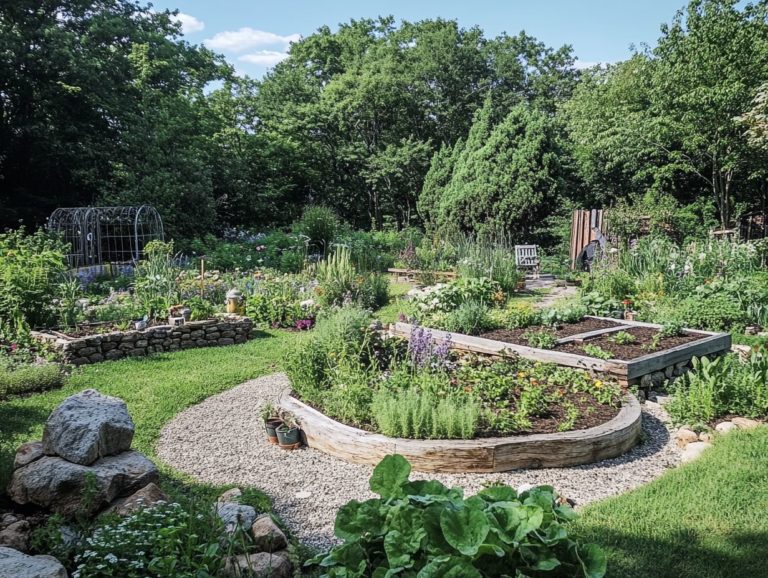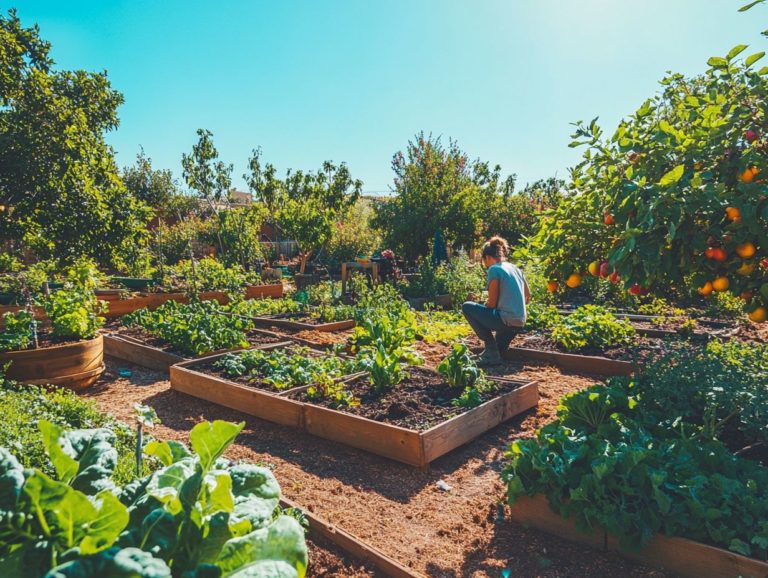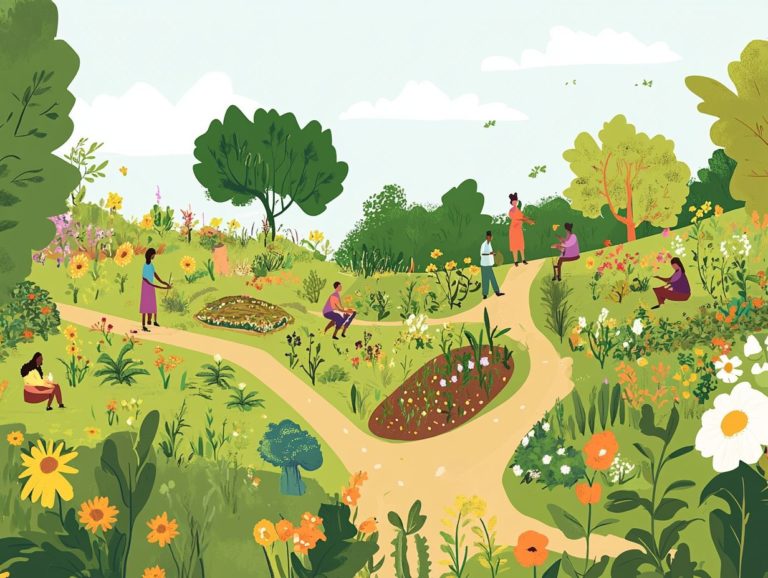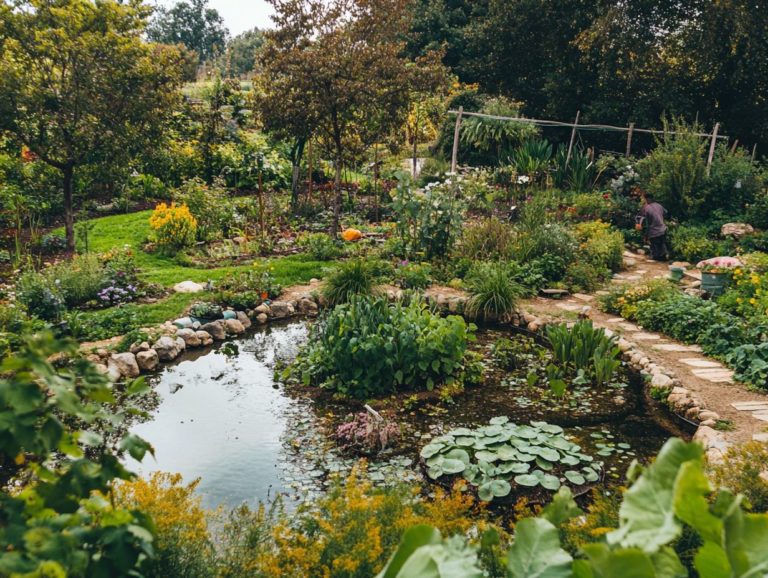Creating a Permaculture Design for Urban Areas
Discover how permaculture can revolutionize sustainable living in our cities! This exploration dives into what urban permaculture is and its core principles, highlighting its many environmental and social benefits.
Successful permaculture design hinges on assessing available space, understanding the local climate, and taking practical steps to establish a resilient system.
With insights on implementation and the importance of community involvement, you ll learn how to cultivate a thriving urban ecosystem through community gardens and food forests that nourish both people and the planet.
Contents
- Key Takeaways:
- Understanding Permaculture
- Benefits of Permaculture in Urban Areas
- Factors to Consider in Permaculture Design for Urban Areas
- Steps to Creating a Permaculture Design
- Implementing and Maintaining the Design
- Community Involvement and Education
- Frequently Asked Questions (FAQs)
- What is permaculture and how can it benefit urban areas?
- Why is it important to consider permaculture in urban areas?
- What are some key elements to consider when creating a permaculture design for urban areas?
- What are some challenges of implementing permaculture in urban areas?
- How can community involvement play a role in creating a successful permaculture design for urban areas?
- Are there any successful examples of permaculture design in urban areas?
Key Takeaways:
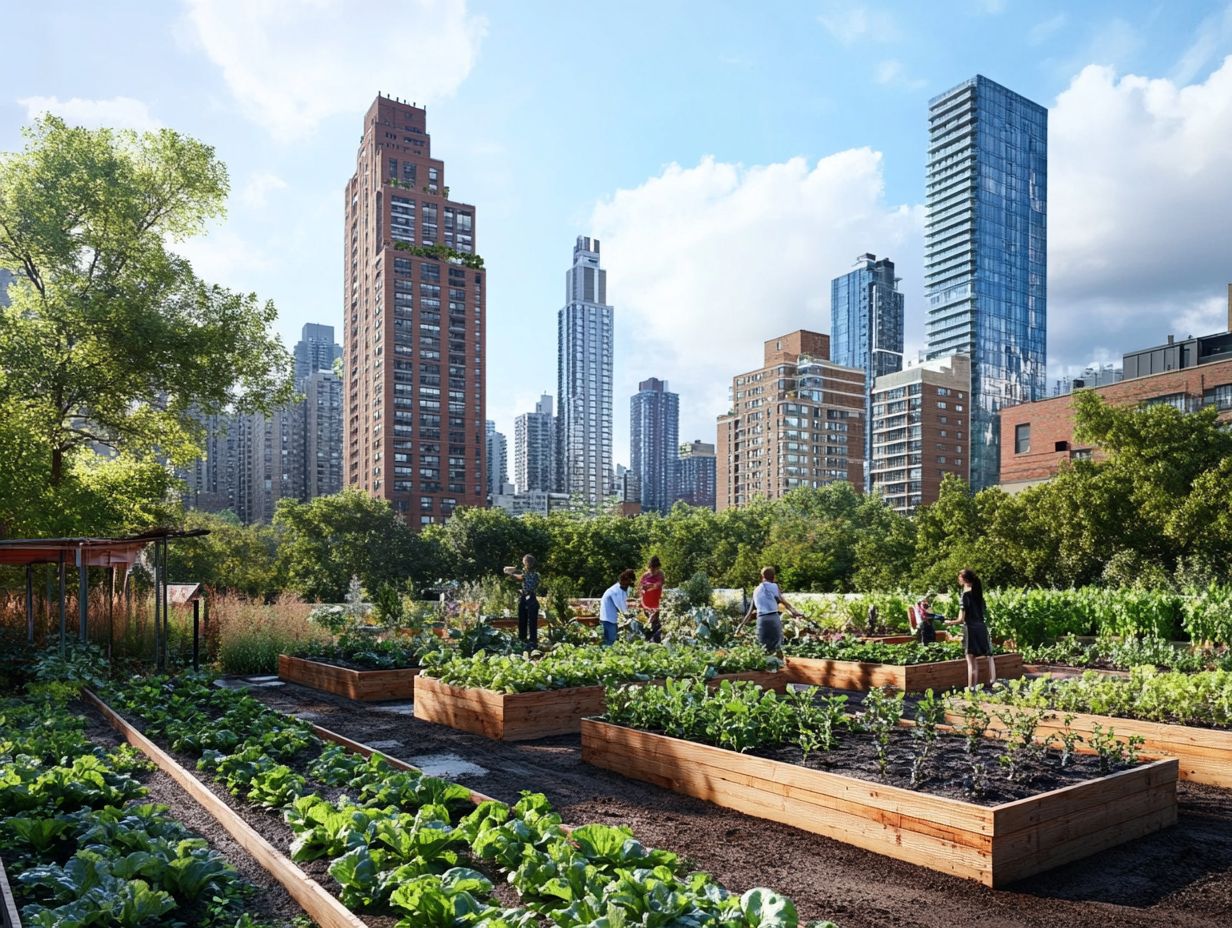
- Permaculture is a holistic approach to designing sustainable systems that mimic natural ecosystems, inspired by Bill Mollison and David Holmgren.
- Creating a permaculture design in urban areas can improve the environment and strengthen communities while integrating design ideas that work with nature.
- When designing for urban areas, it’s crucial to consider local resources, climate, and community engagement for successful and sustainable permaculture.
Understanding Permaculture
Understanding permaculture invites you to explore a design approach that creates sustainable and self-sufficient agricultural systems, drawing inspiration from the groundbreaking work of Bill Mollison and David Holmgren. This methodology combines ecological design ideas that resonate with nature, encouraging the development of community gardens and food forests while enhancing biodiversity in urban ecosystems.
Embracing these practices allows urban permaculture to cultivate sustainable living and regenerative farming techniques, building resilience against the challenges of climate change.
Definition and Principles
Permaculture principles provide a framework for cultivating sustainable and self-sufficient agricultural ecosystems, grounded in ecological design concepts. These guidelines address not just environmental concerns but also social and economic sustainability, highlighting the profound connections between humans and nature.
At their core, these principles emphasize a commitment to the earth. They advocate for responsible use of natural resources and their effective regeneration, while also fostering strong communities and supporting local economies.
By implementing these practices, you contribute to a fair share, ensuring that the abundance from permaculture is distributed equitably, nurturing a sense of community well-being.
Integrating these foundational tenets enhances food security by promoting biodiversity, improving soil health, and reducing reliance on unsustainable agricultural practices. This holistic approach cultivates resilience within our food systems and encourages sustainable living that embraces local farmers and community engagement.
Benefits of Permaculture in Urban Areas
The advantages of permaculture in urban settings extend far beyond gardening; they represent a comprehensive enhancement of urban ecosystems.
By fostering biodiversity, you not only promote food security but also cultivate community engagement through vibrant environmental education initiatives.
Start your own urban permaculture project today and be part of the movement towards a sustainable future!
Environmental and Social Benefits
The environmental and social benefits of permaculture in urban settings are truly remarkable. They drive initiatives that focus on habitat preservation and enhance urban biodiversity.
You ll discover sustainable living practices and wildlife gardening. You will also learn about the creation of urban orchards and community gardens that cultivate social connections.
These initiatives not only enhance habitat preservation, providing essential resources for local wildlife. They also forge vibrant spaces where community members can gather and engage.
Take urban orchards, for example; they offer nourishment not just for people but for pollinators and various other species, thereby fostering biodiversity.
Beyond their ecological impact, these gardens promote collaboration and shared experiences. They help reinforce community ties and instill a sense of ownership.
As these green spaces flourish, they transform into vital economic resources. They positively impact neighboring areas and encourage sustainable practices and lifestyle changes that contribute to overall well-being.
Factors to Consider in Permaculture Design for Urban Areas
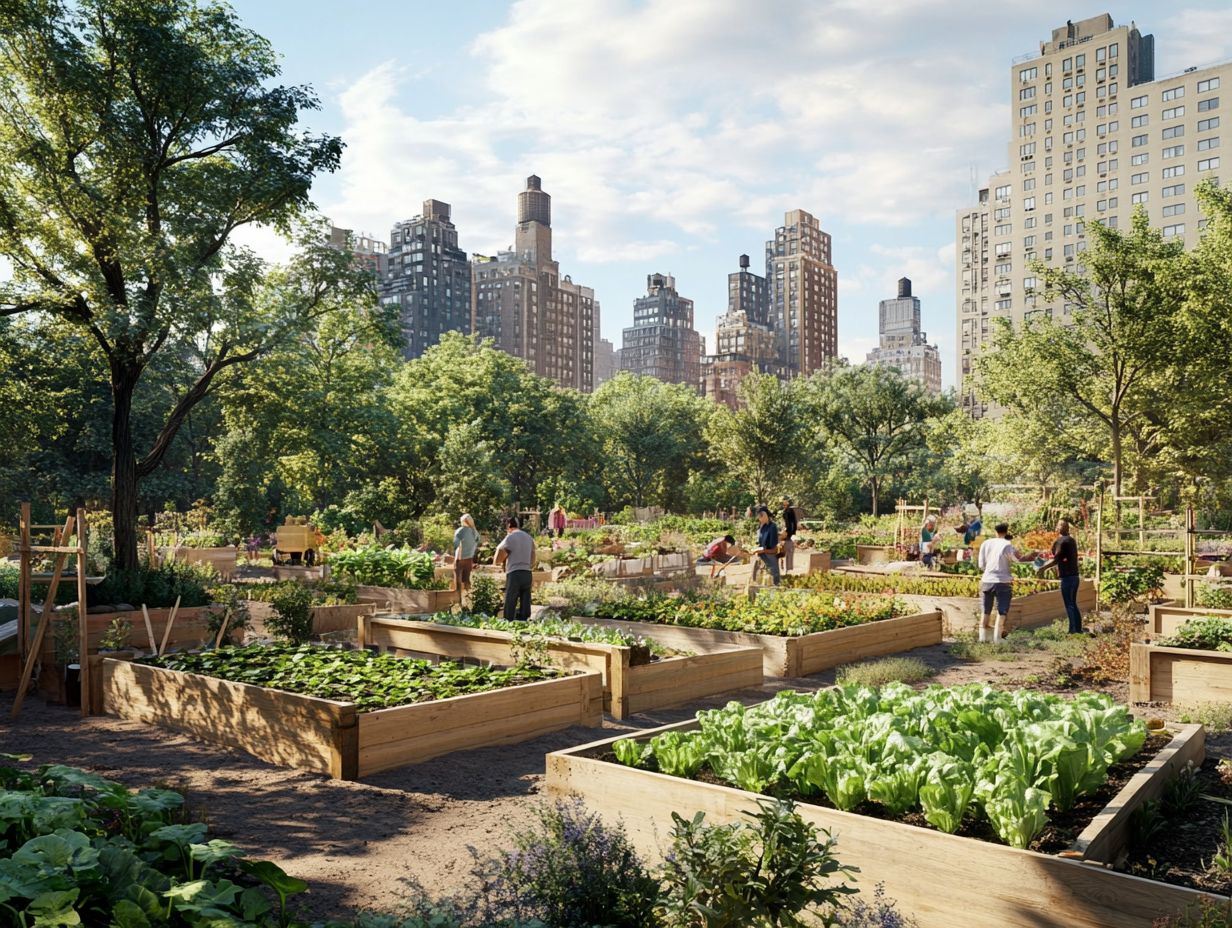
- Available space
- Local climate
- Soil conditions
When considering permaculture design for urban areas, you should take into account these key factors. To ensure success, it’s essential to understand how to create a permaculture design plan, as each element plays a vital role in shaping the feasibility and effectiveness of your urban permaculture initiatives.
By thoughtfully assessing these aspects, you can create a thriving, sustainable environment in your urban setting.
Available Space and Resources
When you embark on the journey of urban permaculture, it’s essential to assess the space and resources at your disposal. Understanding the permaculture design process can greatly influence how these factors shape your gardening practices and designs.
Consider options like edible landscaping. To make the most of your limited outdoor areas, employ innovative strategies such as vertical gardening and container planting.
These techniques can transform your balcony, rooftop, or even a tiny yard into a lush, thriving green space.
Community gardens become invaluable resources. They nurture local grower networks that enhance biodiversity and bolster food security while promoting local farmers.
By incorporating native plants into your garden, you promote sustainability and support the local ecosystems around you.
As an urban dweller, you have access to a wealth of permaculture workshops and resources provided by community organizations. These opportunities enable you to embrace permaculture principles, including how to manage water in urban permaculture, and make the most of every square foot in your urban environment.
Local Climate and Soil Conditions
Local climate and soil conditions are crucial in permaculture design. They guide you in selecting the right plants and nurturing the health of the soil and its organisms in urban settings, especially when designing for biodiversity in permaculture.
By assessing these factors, you can choose native plants that thrive in your specific weather patterns. They also bolster local wildlife.
Understand how sunlight, rainfall, and temperature fluctuations affect plant growth. Recognizing the different kinds of soil, like sandy or clay soil, in your area is essential.
Conducting soil assessments enables you to refine your permaculture zones. This enhances water retention and nutrient distribution.
This strategic organization allows for a more effective use of space and resources. It ultimately promotes environmental sustainability while cultivating a vibrant ecosystem that capitalizes on your local climate.
Steps to Creating a Permaculture Design
Creating a permaculture design requires a thoughtful approach. Begin with a thorough site analysis and assessment.
From there, craft a design that prioritizes sustainability and resilience. This methodical journey can pave the way for obtaining permaculture certification.
Mark your commitment to ecological harmony and innovative land use today!
Site Analysis and Assessment
Site analysis and assessment are essential first steps in permaculture design. These steps ensure that you honor and integrate the unique ecological systems, biodiversity, and permaculture ethics of your area into the planning process.
By examining the topography, soil quality, and hydrology (the study of water movement and distribution), you can uncover the interactions between existing species and their habitats. This thorough evaluation reveals the native flora and fauna while shedding light on important connections in nature that might otherwise escape your notice.
These insights play a pivotal role in crafting a sustainable plan that works in harmony with nature. Ultimately, this approach fosters more resilient ecosystems. Sharing your findings from the site analysis enriches environmental education opportunities. It enables community members to engage in meaningful discussions about conservation and develop a deeper appreciation for their local ecosystem.
Designing for Sustainability and Resilience
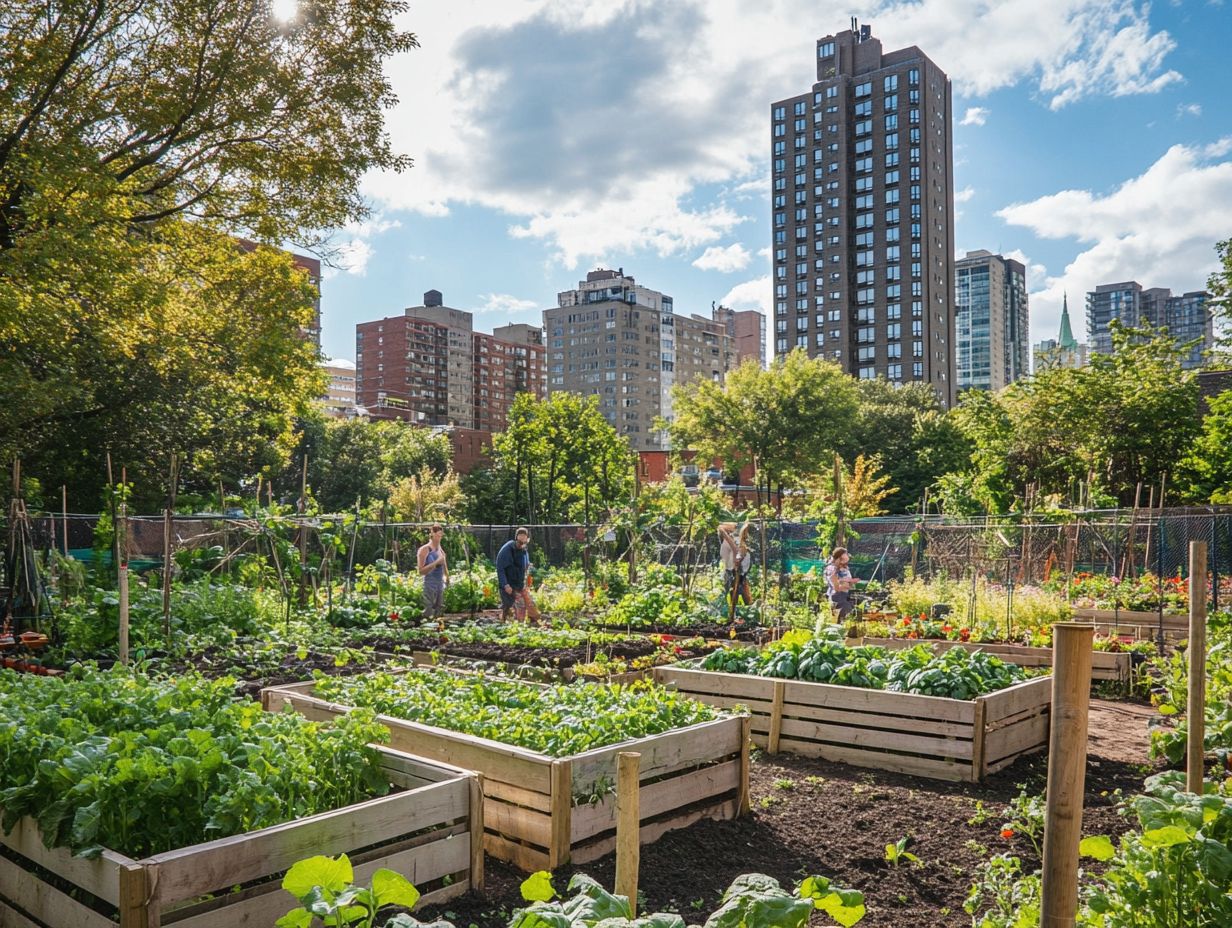
Designing for sustainability and resilience within permaculture invites you to embrace specific principles and innovative gardening techniques. These enable urban ecosystems to adapt seamlessly to various challenges, including climate change.
To achieve this, consider incorporating methods like companion planting, which fosters biodiversity and reduces pest problems. This approach also highlights the importance of soil health through practices such as cover cropping and mulching.
Community gardens exemplify how you can bring these strategies to life. These gardens unite neighbors in the shared pursuit of cultivating food and nurturing social connections.
Initiatives like urban reforestation enhance green spaces and improve air quality. They create ecosystems that are inherently better equipped to withstand environmental stress. Experience the amazing transformation that collaborative sustainability brings to your community, aligning with permaculture ethics.
Implementing and Maintaining the Design
When it comes to implementing and maintaining a permaculture design, a strategic approach is essential. Striking a balance between effective gardening techniques and sustainable maintenance practices is crucial. For those looking to get started, creating a permaculture design for your family can help nurture thriving urban ecosystems.
Practical Tips and Techniques
Practical tips and techniques for urban permaculture can significantly enhance the effectiveness of your design, including exploring permaculture design in small spaces. Solutions like composting improve soil health and champion environmental sustainability.
By embracing organic waste recycling methods like backyard composting or participating in community composting initiatives, you can effortlessly transform kitchen scraps into rich, nutrient-dense soil amendments. This approach reduces landfill waste while nurturing healthy plant growth, which is vital for urban food security through sustainable practices.
Utilize techniques like vertical gardening and interplanting to maximize limited space. These techniques enable the cultivation of diverse crops that attract beneficial insects, thereby enhancing biodiversity. Implement rainwater harvesting systems to provide clean water for irrigation while decreasing your dependence on municipal sources.
Community Involvement and Education
Community involvement and education are essential for the success of urban permaculture. They cultivate a sense of ownership and engagement through initiatives like permaculture workshops and the creation of community gardens.
By participating in these activities, you not only enhance your own knowledge but also contribute to a vibrant, sustainable ecosystem in your neighborhood. This promotes local growers and strengthens community gardens.
Engaging and Educating the Community
Engaging and educating your community about urban permaculture is vital for fostering environmental awareness and promoting the use of permaculture tools and methods to support local farmers and sustainable practices.
Join us for exciting gatherings where you can share your experiences! By hosting interactive workshops and community events, you can immerse yourself in hands-on techniques that encourage sustainable gardening and food production.
These events foster a sense of belonging and teamwork. Local farmers are integral to these initiatives, providing valuable insights and demonstrating best practices that resonate deeply within the community.
Collaborating with educational institutions and community organizations can elevate these efforts. These collaborations offer a diverse range of resources tailored to different learning styles.
Together, the efforts of farmers and community members can cultivate a vibrant ecosystem that honors nature and enables meaningful steps toward sustainability.
Watch this video to learn more about urban permaculture!
Frequently Asked Questions (FAQs)
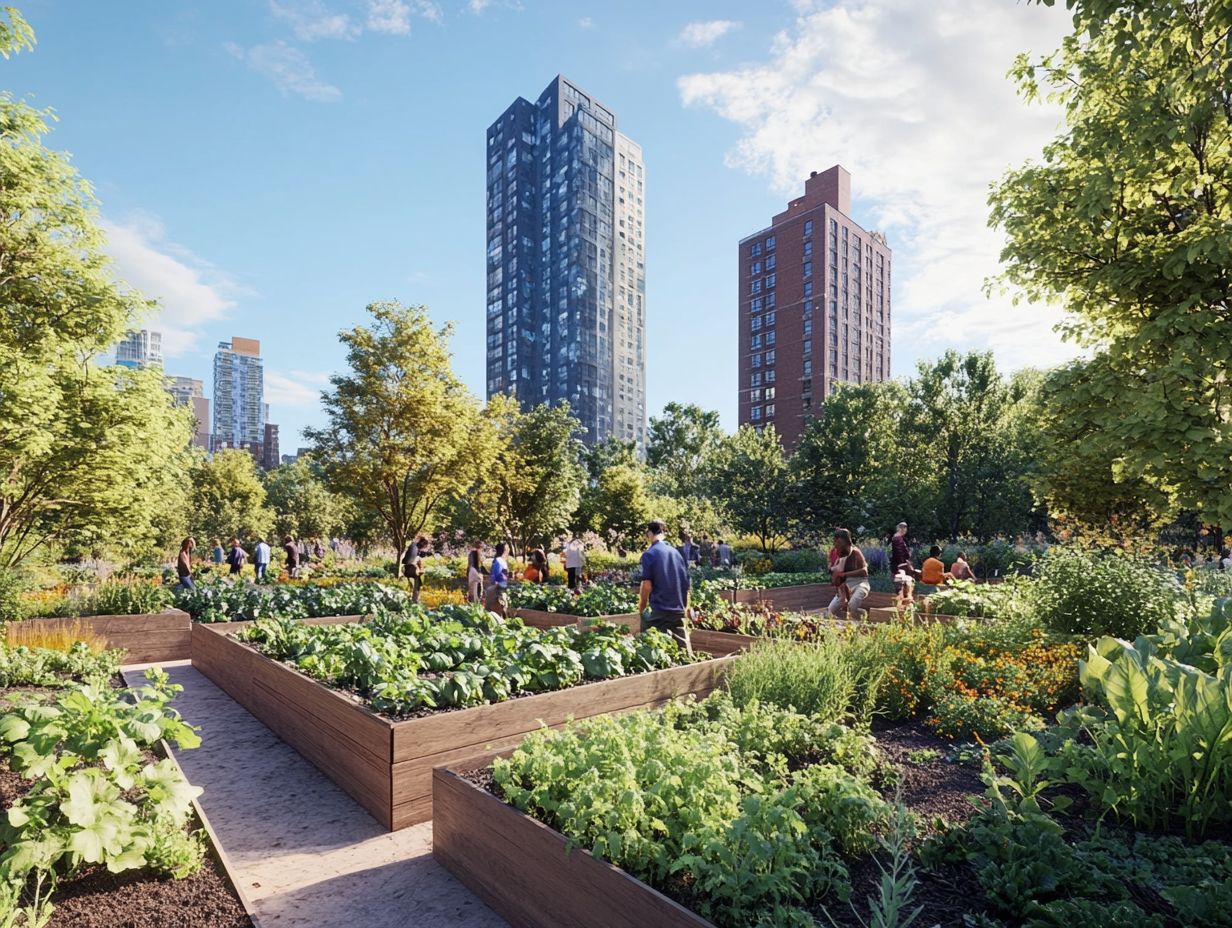
What is permaculture and how can it benefit urban areas?
Permaculture is a method of sustainable farming that works with nature to create sustainable and regenerative human settlements. It can benefit urban areas by providing food, reducing waste, conserving resources, and creating resilient communities.
Why is it important to consider permaculture in urban areas?
As urbanization continues to increase, it is crucial to incorporate sustainable and regenerative practices. This helps mitigate the negative impacts of urban development on the environment and human well-being.
What are some key elements to consider when creating a permaculture design for urban areas?
- Water management
- Food production
- Waste management
- Energy efficiency
- Community engagement
- Biodiversity
These elements work together to create a holistic and regenerative system.
What are some challenges of implementing permaculture in urban areas?
Challenges may include limited space, regulations and restrictions, lack of community support, and the need for education and awareness. However, creative solutions and collaboration can help overcome these challenges.
How can community involvement play a role in creating a successful permaculture design for urban areas?
Community involvement is essential in permaculture. It fosters a sense of ownership and responsibility, promotes diverse ideas and skills, and creates a strong support system for the design. This involvement helps build resilient and self-sufficient communities.
Are there any successful examples of permaculture design in urban areas?
Yes, there are many successful examples of permaculture design in urban areas around the world. Notable projects include designing for social permaculture.
- The Urban Farm in Phoenix, Arizona
- Cityplot in Amsterdam
- Retrosuburbia in Melbourne, Australia
These projects showcase the potential for permaculture design to transform urban areas into sustainable and regenerative communities.

